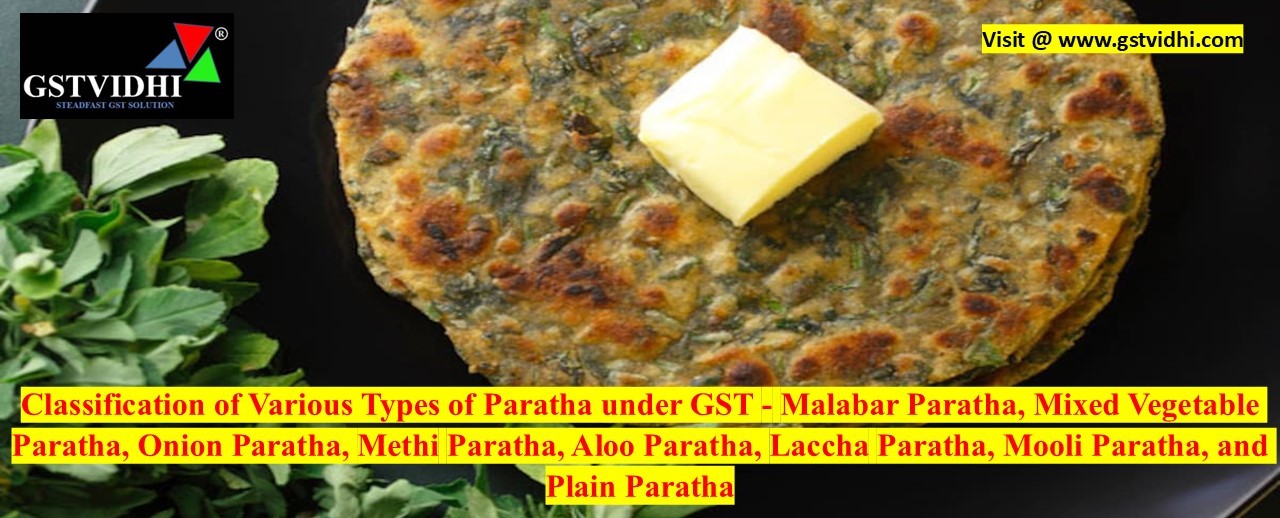
Classification
of Various Types of Paratha under GST – Gujarat Appellate Authority for Advance
Ruling (GAAAR)
Name of
Party: M/s Vadilal Industries Ltd.
Name of
Ruling Authority: Gujarat Appellate Authority for Advance
Ruling (GAAAR).
Ruling No.:
GUJ/GAAAR/APPEAL/2022/23.
Date of
Ruling: 15.09.2022.
Summary of
Ruling:
The Gujarat Appellate
Authority for Advance Ruling (GAAAR) upheld the ruling of the Gujarat Authority
for Advance Ruling (GAAR), classifying various types of Paratha under HSN Code
21069099 instead of 19059090. As a result, Paratha is liable to GST at 18% (9%
CGST + 9% SGST) instead of 5% as applicable to plain roti or chapatti.
Facts of
Advance Ruling:
- The applicant, Vadilal Industries
Ltd., manufactures and sells eight types of Parathas: Malabar Paratha,
Mixed Vegetable Paratha, Onion Paratha, Methi Paratha, Aloo Paratha,
Laccha Paratha, Mooli Paratha, and Plain Paratha.
- These Parathas are sold in a packed
and frozen condition.
- The Parathas require cooking on a pan
or griddle for 3-4 minutes before consumption.
- The main ingredient of all varieties
of Paratha is wheat flour, along with other ingredients such as oil, salt,
and vegetables.
- The applicant contended that Paratha
is similar to roti or chapatti and should be classified under HSN Code
19059090, attracting 5% GST under Notification No. 01/2017-CT (Rate).
Question
Raised:
1. Whether
the various types of Paratha manufactured by the applicant fall under HSN Code
19059090?
2. Whether
Paratha is chargeable to GST at 5% under Sl.No. 99A of Schedule I of
Notification No. 01/2017-CT (Rate)?
Submission
Made by Applicant:
- The applicant argued that Paratha is
akin to chapatti or roti and is consumed in a similar manner.
- Cited that pizza bread, which also
requires heating, is classified under HSN 1905 and is eligible for 5% GST.
- Argued that the GAAR incorrectly
applied classification principles and that Paratha should be classified
under HSN 19059090.
- Relied on Maharashtra AAR’s ruling in
M/s Signature International Foods India Pvt Ltd, which classified Paratha
under HSN 1905 with a 5% GST rate.
Relevant
Sections & Notifications:
- Section 100 of the CGST Act, 2017
– Governing appeals against Advance Rulings.
- Rule 3(b) of Rules for Interpretation
of Tariff – Essential character test for
classification.
- HSN Code 1905
– Covers baked goods like bread, pastry, cakes, and biscuits.
- HSN Code 2106
– Covers food preparations not elsewhere specified.
- Notification No. 01/2017-CT (Rate)
– Specifies GST rates for various goods.
Discussion
and Findings of Ruling Authority:
- GAAR held that Parathas require
further cooking and are not ready-to-eat products like roti or chapatti,
which are included in HSN 1905.
- GAAR classified Parathas under HSN
Code 21069099, attracting an 18% GST rate.
- The appellate authority observed that
Parathas contain additional ingredients like margarine, emulsifying
agents, and vegetables, making them different from plain chapatti or roti.
- Applied Rule 3(c) of Tariff
Interpretation, holding that since Paratha does not qualify under HSN
1905, it falls under HSN 2106 as a food preparation not elsewhere
specified.
- Dismissed the Maharashtra AAR ruling
in Signature International Foods case, stating that each ruling is binding
only on the applicant.
Final
Ruling and Conclusion:
- The appeal was rejected, and
the classification of Paratha under HSN 21069099 was upheld.
- Paratha is liable to GST at 18% (9%
CGST + 9% SGST).
- GAAR’s ruling in Advance Ruling
No. GUJ/GAAR/R/20/2021 dated 30.06.2021 was confirmed.
- The authority ruled that Paratha is not
the same as roti or chapatti and does not qualify for the 5% GST rate.
Disclaimer: All the Information is based on the notification, circular and order issued by the Govt. authority and judgement delivered by the court or the authority information is strictly for educational purposes and on the basis of our best understanding of laws & not binding on anyone.
Find the Attachment (Press on Click Here )
Click here